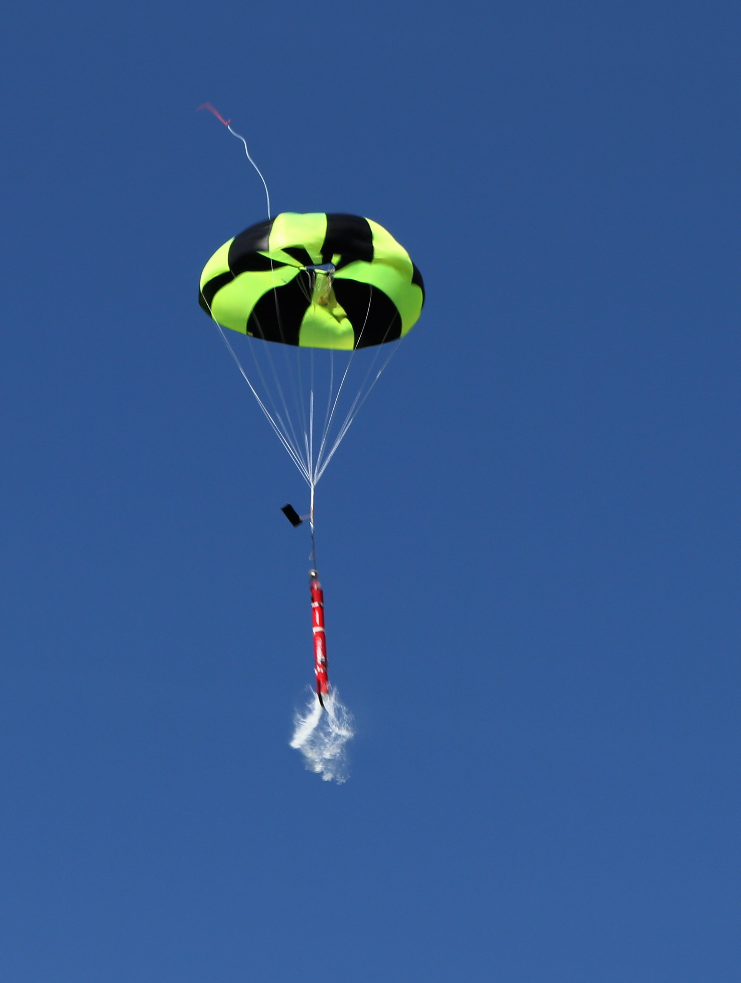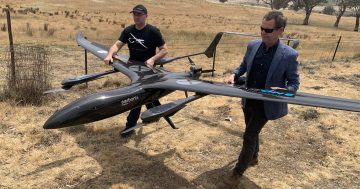
Dr Roslyn Prinsley with the prototype water-glider to extinguish lightning fires within five minutes. Photo: Supplied.
What if lightning fires could be detected within one minute and extinguished within five, even in remote bushland?
That’s the aim of a group of ANU (Australian National University) researchers led by Dr Roslyn Prinsley.
The idea was sparked as Canberrans choked through intense smoke during the 2019/2020 Black Summer bushfires.
“I kept thinking ‘I can’t breathe, this is crazy’,” Dr Prinsley said.
“I was also thinking of the millions of animals dying and the environmental damage; we emitted more than double our greenhouse gases that year.”
Head of Disaster Solutions at the Institute for Climate, Energy and Disaster Solutions, Dr Prinsley said about 90 per cent of the Black Summer bushfires were ignited in remote areas by lightning and weren’t seen until they were already large.
Given their remoteness, it also took time for fire trucks to reach them.
So Dr Prinsley decided to turn traditional bushfire fighting on its head.
“Instead of waiting until the fires became so large that it was impossible to extinguish them, could we detect these remote ignitions as soon as they started and put them out before they became too large to extinguish?” she pondered.
“I looked at what we were doing at the ANU and thought ‘we have people here researching clearing space junk out of the sky, but we can’t put out fires?’.
“What if we turned telescopes the other way and instead of finding stars, we detect tiny fires?”
Dr Prinsley brought together ANU researchers from space, defence, physics, computer science, engineering and earth observation technologies, along with bushfire and environmental scientists and firefighters.
They included lead detection researcher Marta Yebra and Dr Andrew Tridgell, who designed drone auto-pilot software.
From this, the ANU Bushfire Initiative was born.
“We agreed that through harnessing new technologies we could aim to eliminate the risk of rapid development of bushfires under such extreme conditions,” she said.
“The key to this approach is to recognise that when a bushfire ignites, every second counts.”
The first idea was to put a detector on satellites as an “eye in the sky”. But the team decided these may not reliably identify small ignitions due to current spatial resolution constraints and they couldn’t “see through” clouds.
This led researchers to Dr Tridgell’s drones.
Working with ACT Rural Fire Service and the ACT Parks and Conservation Service, researchers lit small fires in drums and set off smoke machines in dense bushland to see if they could be spotted by drones.
The operation was a success.
“A thermal video has now been collected by a drone over these experimental sources of heat and smoke,” Dr Prinsley said.
“The drones are fast with long endurance and can get there very quickly, so they chase the lightning.”
However, there can be thousands of lightning strikes within a storm. So the ANU approached US-based company FNN which has been developing technology to identify the strikes most likely to start a fire.
That can narrow down which strikes the drone should investigate.
“We’re in the process of setting up detectors across the ACT to trial this over the next few months,” Dr Prinsley said.
“We’re also working with CASA [Civil Aviation Safety Authority] around flying a drone beyond visual line of sight.”
The ANU has now partnered with Optus in the ACT to develop advanced technologies to detect a small ignition, including satellite, drones, cameras on fire towers with AI and ground sensors.
But once the fire has been detected, how can it rapidly be put out?
The answer – from the air.
“Andrew Tridgell had the idea for a water-glider with a parachute, recalling his work with JPADS, guided parachute payloads designed for cargo planes to drop supplies from altitudes of up to 7500 metres into remote areas,” she said.
A prototype – named the ANU Waterglider – has been developed and successfully tested by Dr Tridgell, Rob Mahony and ANU Honours students to burst water as the parachute opens.
“The GPS-guided biodegradable water-gliders are accurate and fast from high altitudes. Unlike piloted aircraft, they can be deployed in all weather, night and day,” Dr Prinsley said.
“They would be in a cargo plane high in the sky. When the drone identifies an ignition, the water-glider would drop out of the plane at 400 kph with half a tonne of water and the auto pilot would guide it to the ignition.
“They could also be useful to put out spot fires.”

The water-glider prototype in action. Photo: Supplied.
While Optus and the ANU are providing funding for five years for the detection technologies, more money is needed to advance the prototype to its full potential.
But Dr Prinsley is determined to keep going with her research – with or without the money.
“I don’t think we have a choice. As with these types of catastrophic fires in 2019-20, no amount of hazard reduction burning will prevent them.
“We’re targeting those extreme bushfire conditions where we desperately need new solutions.”

















